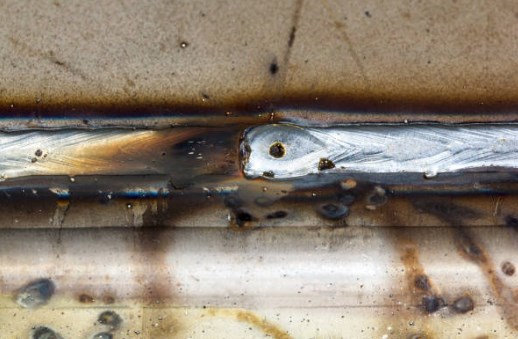Welding is a critical process in the fabrication and construction of various structures and components. It involves the joining of materials, usually metals or thermoplastics, by causing coalescence. This is typically done by melting the workpieces and adding a filler material to form a pool of molten material that cools to become a strong joint. However, the integrity of this joint can be compromised by various welding defects, among which welding pores and welding undercuts are quite common. Understanding these defects and their impact on the weld joint is crucial for maintaining the quality and safety of the welded structure.
I. Understanding Pores in Welding
Pores are small voids or cavities that form within the weld metal. These imperfections are often caused by the entrapment of gas within the molten weld pool. The presence of pores in a weld can significantly reduce its mechanical strength and lead to failure under stress. Pores can be spherical, elongated, or irregular in shape, and their size can vary from microscopic to visible to the naked eye.

1) Causes of Porosity in Welding
The genesis of porosity is often attributed to several factors, including:
Contaminants: The presence of dirt, oil, moisture, or rust on the base metal or filler material can introduce gases into the weld pool.
Shielding Gas Problems: Incorrect gas flow rate, gas composition, or turbulence can lead to inadequate shielding and entrapment of atmospheric gases.
Welding Technique: Improper welding techniques, such as incorrect travel speed or arc length, can contribute to gas entrapment.
Material Properties: Certain materials are more prone to porosity due to their chemical composition, such as aluminum which has a high affinity for hydrogen.
2) Effect of Pores on Weld Strength and Integrity
Porosity can lead to a range of issues, including:
Reduced Tensile Strength: Pores act as stress concentrators, weakening the weld and reducing its load-bearing capacity.
Decreased Fatigue Life: Under cyclic loading, the presence of pores can accelerate the initiation and propagation of cracks.
Compromised Aesthetics: Visible pores can be unsightly and may require additional finishing work.
For details, read Porosity in Welding: Causes, Types, Effects and Solutions.
II. Undercutting in Welding
Welding undercuts are grooves or channels that form along the edges of the weld bead, at the toe of the weld. They occur when the base metal melts away without being filled by weld metal, leaving a weak spot in the joint.
1) Causes of Welding Undercutting
Factors leading to undercutting include:
Excessive Welding Current: High current settings can lead to a wider arc, causing more melting of the base metal than necessary.
Improper Welding Speed: Moving the torch too fast or too slow can result in uneven distribution of the weld metal.
Incorrect Electrode Angle: An angle that’s too steep or shallow can direct the heat away from the desired area, leading to insufficient fill.
Material Properties: Some materials are more susceptible to undercuts due to their thermal conductivity and melting characteristics.
2) Effect of Undercuts on Weld Strength and Integrity
Weld Undercutting can compromise the weld in several ways:
Reduced Cross-Sectional Area: The groove created by weld undercutting reduces the effective cross-sectional area of the weld, diminishing its strength.
Stress Concentration: Undercuts create sharp notches that concentrate stress, making the joint more susceptible to cracking.
Corrosion Susceptibility: The irregular surface of an undercut weld can trap moisture and debris, promoting corrosion.
For details, read Undercut Welding Defect: Causes, Prevention, and Repair.
III. Detecting and Preventing Welding Defects
Detecting and preventing welding defects, particularly pores and undercuts, is essential for ensuring the structural integrity and longevity of welded joints. Here are some strategies to help reduce the occurrence of these defects:
1) Detecting and Preventing Methods for Pores
Non-Destructive Testing (NDT): Techniques such as radiographic (X-ray) and ultrasonic testing can reveal internal porosity.
Pre-Weld Preparation: Thorough cleaning of the base and filler materials to remove contaminants is crucial.
Optimized Welding Parameters: Adjusting the welding parameters to suit the material and application can minimize the risk of porosity.
Proper Shielding Gas Usage: Using the correct type and flow of shielding gas can protect the weld pool from atmospheric contamination.
2) Detecting and Preventing Methods for Weld Undercutting
Visual Inspection: Regular checks during and after welding can identify undercuts early.
Controlled Welding Parameters: Adjusting the current, speed, and electrode angle can help prevent the formation of undercuts.
Proper Technique Training: Skilled welders with the right technique are less likely to produce undercuts.
Material Selection: Choosing materials that are less prone to undercuts can also be a preventive measure.
Conclusion
Welding defects like pores and undercuts can have a significant impact on the strength, durability, and appearance of a weld joint. By understanding the causes and effects of these defects, welders can take proactive measures to prevent them, ensuring the integrity of the welded structure. Regular inspection and testing of welds can also help identify and rectify any defects before they lead to failure.
Related articles:
1. How to Identify the 7 Most Dangerous Welding Defects?
2. Tips for Troubleshooting Common MIG Weld Defects
3. Undercut Welding Defect: Causes, Prevention, and Repair
4. Welding Defects and Remedies in Steel Material
5. Welding Defects, Problems And Easy Solutions [2023]




